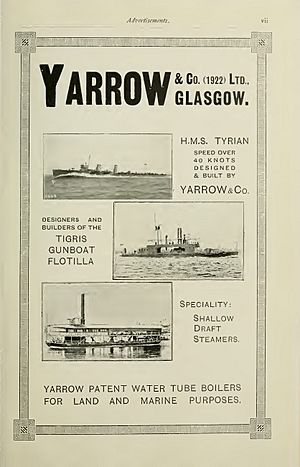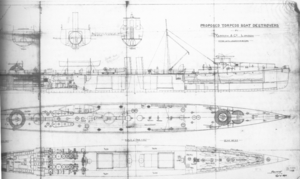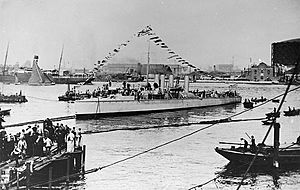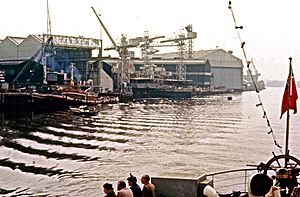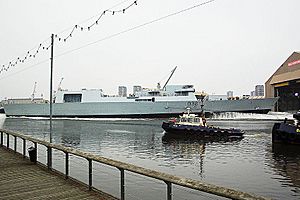Yarrow Shipbuilders facts for kids
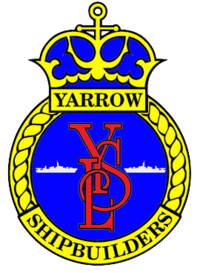 |
|
| Public company | |
| Industry | Shipbuilding |
| Fate | Merged with others to form British Shipbuilders (1977–1985) |
| Successor | GEC Marconi Marine (YSL) (1985–1999) BAE Systems Marine (1999–2003) BAE Systems Naval Ships (2003–2006) BAE Systems Surface Fleet Solutions (2006–2008) BVT Surface Fleet (2008–2009) BAE Systems Surface Ships (2009–) |
| Founded | 1865 |
| Headquarters | Scotstoun, Glasgow, UK |
|
Key people
|
Sir Alfred Yarrow Sir Harold Yarrow Sir Eric Yarrow Sir Arnold Weinstock Sir Robert Easton Murray Easton CBE |
| Products | Naval ships Merchant ships Marine steam engines Marine engines Boilers |
|
Number of employees
|
Approximately 3,000 |
| Parent | Upper Clyde Shipbuilders (1968–1970) Yarrow & Co. Ltd. (1970–1977) British Shipbuilders (1977–1985) GEC Marconi (1985–1999) BAE Systems (1999–) |
| Subsidiaries | Coventry Ordnance Works (1905–1925) |
Yarrow Shipbuilders Limited (YSL), often called Yarrows, was a big company that built ships. It was located in Scotstoun, a part of Glasgow, Scotland, right on the River Clyde. Today, it is part of BAE Systems Surface Ships, which is owned by BAE Systems. This company also runs the nearby Govan shipyard.
Contents
History of Yarrow Shipbuilders
Starting in London
The company began in 1865. It was founded by Alfred Yarrow, who later became Sir Alfred Yarrow. Back then, it was called Yarrow & Company, Limited.
The first shipyard was in Poplar, London. As the company grew, Yarrow moved his shipyard to a bigger spot in Cubitt Town in 1898. From 1869 to 1908, Yarrow's London shipyards built many steam launches and river boats. They also built the Royal Navy's first destroyers, like the Havock class.
Yarrow also made special boilers. A type of boiler they invented was called the "Yarrow boiler". It was first used in a torpedo boat in 1887. These boilers were used in many places, even in the famous RMS Queen Mary ship. Making boilers helped the company survive when shipbuilding was slow.
Alfred Yarrow was a very clever engineer. He invented new things that made warships much faster. People started saying that a "Yarrow ship was a fast ship." His company built the first naval ship in the world to go faster than 30 knots. Later, they built one that went over 40 knots! Sir Alfred Yarrow was knighted in 1916 for his help during the war. He also gave a lot of money to charities.
Moving to Glasgow
Yarrow's London shipyard became too small. Also, it was expensive to build ships and pay workers in London. So, in 1906, Yarrow moved its shipyard to a new, empty area in Scotstoun, Glasgow.
Moving everything was a huge job. They had to transport thousands of tons of materials, from small models to heavy machines. Trains carried many wagons of equipment from London to Glasgow every day.
The first ship launched from the new Scotstoun shipyard was on July 14, 1908. It was the lead ship of the Pará-class destroyers for the Brazilian Navy. Sir Harold Yarrow, Alfred's oldest son, was in charge of the move to Scotland. He then ran the company there.
In 1905, the company also started a joint business called Coventry Ordnance Works. They built a large factory near the Scotstoun Shipyard in 1910. During the First World War, Yarrow helped create the first artificial limbs with Sir William Macewen. Sir Harold Yarrow also helped start the Erskine Hospital for injured soldiers. Yarrow's workshops made these artificial limbs without making any profit.
Yarrow became one of the best builders of destroyers and frigates in the world. They built ships for the Royal Navy and many other countries. For many years, until the 1960s, Yarrow also built many merchant ships. They were especially good at making Riverboat vessels for rivers and lakes in places like Burma, India, Africa, and South America.
Some of these boats were built for lakes that couldn't be reached by sea. So, they were built as "knock downs." This meant they were put together temporarily at the shipyard. Then, they were taken apart into many sections. These sections were transported to the lake, put back together, and launched. For example, Yarrow's Scotstoun yard built the "knock down" ferry MV Ilala for Nyasaland in 1949. It was launched on Lake Nyasa (now Lake Malawi) in 1951.
The yard also built three "knock down" ferries for Lake Victoria in East Africa. RMS Victoria was built in Scotstoun in 1960. It was put back together in Kenya in 1961. The train ferries MV Umoja and MV Uhuru were built in Scotstoun in 1965. They were reassembled in Kenya in 1965 and 1966.
In total, Yarrow built about 400 ships on the Clyde River. You can find details about them in the Clyde-built Ship Database.
The shipyard kept growing after the war. In 1964, they bought the nearby Blythswood Shipbuilding Company. Yarrow used this new land to make their shipyard bigger. They built three covered areas for building ships and a six-story office building. The government helped pay for this. They also bought other nearby yards to make their waterfront longer. Sir Eric Yarrow, who became chairman in 1962, helped arrange these deals. He was the third generation of the Yarrow family to lead the company.
During this time, Yarrow designed and built many ships for the Royal Navy. These included the Type 81 Tribal class, Type 14 Blackwood class, and Type 12M Rothesay-class frigates. They also worked on the Leander class ships. In the 1960s, they built ships for the navies of South Africa, Chile, Malaysia, Thailand, New Zealand, and Iran.
Upper Clyde Shipbuilders and Aftermath
In 1968, Yarrow became part of a group called Upper Clyde Shipbuilders. This group faced problems and collapsed in 1971. However, Yarrows had already left the group by April 1970. This was because Yarrows was the only part of the group that was making money.
In 1974, Yarrow bought the nearby Elderslie Dockyard. This dockyard had three drydocks (docks that can be drained of water for ship repair). These dry docks were built in 1904, 1933, and 1965. During this time, Yarrow worked on the Type 12I Leander-class frigate program. They also built the Condell-class frigate for the Chilean Navy and designed the Nilgiri-class frigate for the Indian Navy.
Yarrow was good at investing in its facilities and building ships. They also developed the Yarrow Admiralty Research Department (YARD). Because of this, when the Navy reduced the number of warship yards in the 1970s, Yarrows was chosen as one of the main builders. They built many important ships like the Type 21, Type 22, Type 23, and Type 45 destroyers for the Royal Navy. The Type 21 was the first Navy ship to use both gas turbine and diesel engines. Five out of eight Type 21s, ten out of fourteen Type 22s, twelve out of sixteen Type 23s, and all the Type 45s were built at Scotstoun. This shows how important the company was for medium-sized Royal Navy ships.
The Type 21 frigates looked sleek and were very fast. Their captains were sometimes called "boy racers." These ships could stop from full speed in a very short distance. All the Type 21s built by Yarrow served in the Falklands War.
Becoming a National Company
In 1977, the government decided to take over Yarrow (Shipbuilders), Limited. This was done through a law called the Aircraft and Shipbuilding Industries Act 1977. Yarrow and other big British shipyards became part of a company called British Shipbuilders. The owners of Yarrow and the Conservative party did not agree with this takeover.
The last ship launched while the company was privately owned was HMS Battleaxe (F89). It was a Type 22 frigate. Even after the takeover, money was still invested in the shipyard. A large hall for making GRP parts was built in the late 1970s. Dry dock No.1 was also covered. This was for the Hunt-class mine countermeasures vessel project. However, only two of these ships were built at Yarrow. The hall was later taken down in 2008.
The original Yarrow company, Yarrow PLC, still owned parts of the business that didn't build ships, like YARD Ltd. Yarrow plc was later sold to other companies.
Becoming a Private Company Again
The next government, led by Margaret Thatcher, started selling off government-owned companies. Yarrow was making money, so it was one of the first shipyards to be sold. In 1985, it was sold to GEC's GEC-Marconi division. It was then called Marconi Marine (YSL).
GEC invested a lot of money into the shipyard. They built a large Module Hall in 1987. During this time, they mainly worked on the Type 22 Broadsword class and Type 23 Duke class frigates for the Royal Navy. They also built the Lekiu-class frigate for the Royal Malaysian Navy and the Type 45 Destroyers for the Royal Navy.
In 1999, Marconi Electronic Systems was sold to British Aerospace. This created a new company called BAE Systems. Marconi Marine (YSL) then became part of BAE Systems Marine. Since 2009, YSL has been part of BAE Systems Surface Ships, which is a company owned by BAE Systems.
Ships Built by Yarrow Shipbuilders
| Built in London | Built in Glasgow | Built in Canada |
|---|---|---|
|
|
|
Clyde-class RNLI Lifeboats
- Charles H Barrett (70-001)
- Grace Paterson Ritchie (70-002)
- KD Hang Tuah (F76) (used to be Black Star, then HMS Mermaid)
- KD Rahmat (F24)
- Lekiu-class frigates
- KD Jebat (F29)
- KD Lekiu (F30)
Yarrows Ltd. in Canada
Yarrows Ltd. was a big shipyard in Esquimalt, British Columbia, on the west coast of Vancouver Island, Canada. It started in 1893 as the Esquimalt Marine Railway Co.. Later, it was called B.C. Marine Railway Co.. W. Fitzherbert Bullen owned it, and it had small ship repair facilities in Victoria and Vancouver.
Sir Alfred Yarrow bought this shipyard in 1913 and renamed it Yarrows Ltd. He put his son, Norman Yarrow, in charge. At first, it built ships for the Canadian Pacific Railway. During the First World War, the yard grew to repair and fix many ships for the Royal Navy. It employed up to 800 people.
In the late 1920s, a larger graving dock (a dry dock for ship repair) was finished in Esquimalt. During the Second World War, the company built many ships. These included corvettes, frigates, landing ships, and transport ferries for the Royal Navy and Royal Canadian Navy. They also built cargo ships. Other work included adding weapons to civilian ships and changing some into troop carriers. At its busiest, 3,500 men and women worked at Yarrows in Canada.
After the war, the Yarrow family sold the yard to Burrard Dry Dock. The sale was completed on April 15, 1946. The shipyard closed in 1994. Today, the graving dock and the land are part of the Canadian Forces Base Esquimalt.


